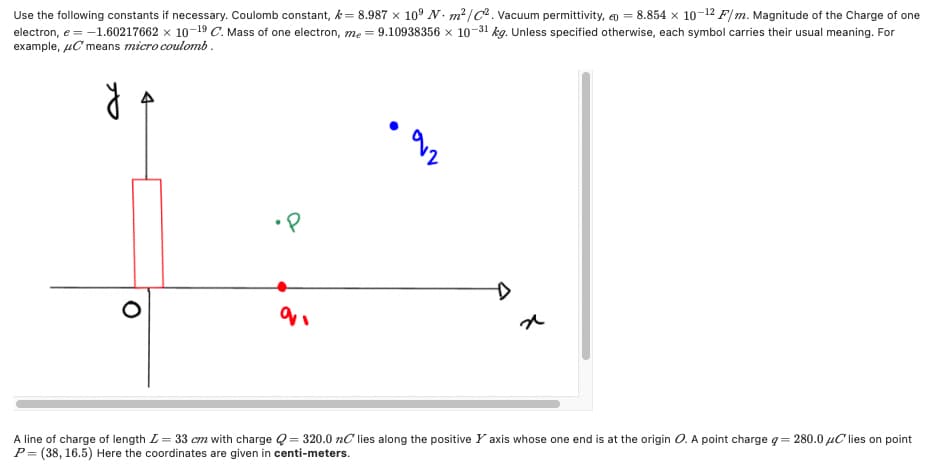[Use The Picture] Now, There is a charge q1=47nC at p1=(16.5,0) and q2=29nC at p2=(19,23). Remember all the coordinates are in centimeters. What is the net force on q1? [Give answer in X and Y coordinates]
[Use The Picture] Now, There is a charge q1=47nC at p1=(16.5,0) and q2=29nC at p2=(19,23). Remember all the coordinates are in centimeters. What is the net force on q1? [Give answer in X and Y coordinates]
Physics for Scientists and Engineers, Technology Update (No access codes included)
9th Edition
ISBN:9781305116399
Author:Raymond A. Serway, John W. Jewett
Publisher:Raymond A. Serway, John W. Jewett
Chapter24: Gauss’s Law
Section: Chapter Questions
Problem 24.36P: Review. A particle with a charge of 60.0 nC is placed at the center of a nonconducting spherical...
Related questions
Concept explainers
Dielectric Constant Of Water
Water constitutes about 70% of earth. Some important distinguishing properties of water are high molar concentration, small dissociation constant and high dielectric constant.
Electrostatic Potential and Capacitance
An electrostatic force is a force caused by stationary electric charges /fields. The electrostatic force is caused by the transfer of electrons in conducting materials. Coulomb’s law determines the amount of force between two stationary, charged particles. The electric force is the force which acts between two stationary charges. It is also called Coulomb force.
Question
100%
[Use The Picture]
Now, There is a charge q1=47nC at p1=(16.5,0) and q2=29nC at p2=(19,23). Remember all the coordinates are in centimeters.
What is the net force on q1?
[Give answer in X and Y coordinates]

Transcribed Image Text:Use the following constants if necessary. Coulomb constant, = 8.987 × 10° N. m²/C². Vacuum permittivity, = 8.854 x 10-12 F/ m. Magnitude of the Charge of one
electron, e = -1.60217662 x 10-19 C. Mass of one electron, me = 9.10938356 x 10-31 kg. Unless specified otherwise, each symbol carries their usual meaning. For
example, uC means micro coulomb.
A line of charge of length L = 33 cm with charge Q= 320.0 nC lies along the positive Y axis whose one end is at the origin 0. A point charge g= 280.0 µC lies on point
P= (38, 16.5) Here the coordinates are given in centi-meters.
Expert Solution
This question has been solved!
Explore an expertly crafted, step-by-step solution for a thorough understanding of key concepts.
Step by step
Solved in 3 steps

Knowledge Booster
Learn more about
Need a deep-dive on the concept behind this application? Look no further. Learn more about this topic, physics and related others by exploring similar questions and additional content below.Recommended textbooks for you

Physics for Scientists and Engineers, Technology …
Physics
ISBN:
9781305116399
Author:
Raymond A. Serway, John W. Jewett
Publisher:
Cengage Learning

College Physics
Physics
ISBN:
9781938168000
Author:
Paul Peter Urone, Roger Hinrichs
Publisher:
OpenStax College

College Physics
Physics
ISBN:
9781305952300
Author:
Raymond A. Serway, Chris Vuille
Publisher:
Cengage Learning

Physics for Scientists and Engineers, Technology …
Physics
ISBN:
9781305116399
Author:
Raymond A. Serway, John W. Jewett
Publisher:
Cengage Learning

College Physics
Physics
ISBN:
9781938168000
Author:
Paul Peter Urone, Roger Hinrichs
Publisher:
OpenStax College

College Physics
Physics
ISBN:
9781305952300
Author:
Raymond A. Serway, Chris Vuille
Publisher:
Cengage Learning

College Physics
Physics
ISBN:
9781285737027
Author:
Raymond A. Serway, Chris Vuille
Publisher:
Cengage Learning

Principles of Physics: A Calculus-Based Text
Physics
ISBN:
9781133104261
Author:
Raymond A. Serway, John W. Jewett
Publisher:
Cengage Learning
